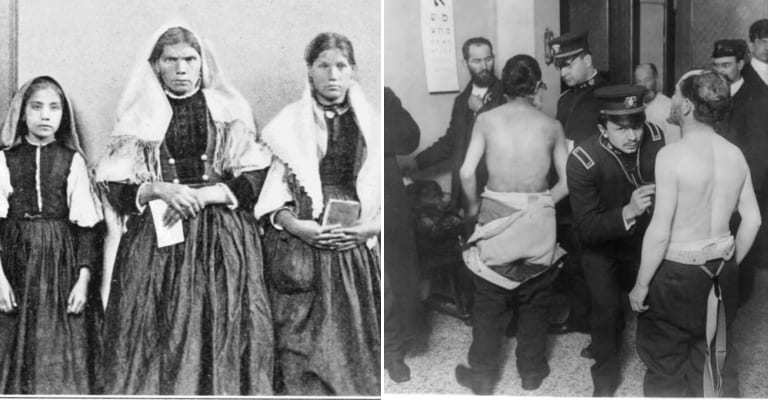During the colonial period of American history, Europeans came to the New World for a diverse number of reasons, including religious persecution at home, indebtedness, illegitimate birth, escaping wives or husbands, business failures, and a desire for a new life. Many came as indentured servants, a status not far removed from outright slavery in some cases. Others were runaway apprentices. They came from Scotland, Ireland, Sweden, the German provinces, the Low Countries, Spain, France, and of course England. The majority were Protestants of various denominations, though Maryland became a haven for English Catholics. The French settled mostly in Canada and New Orleans, the Spanish in New Spain.
The revolutionary period and its aftermath saw a slowing of new arrivals in the recently created United States, and a significant emigration of former Loyalists to the British territories in Canada. They were joined by a large number of Germans, including former mercenaries which had served with the British and had no desire to return to the principalities from whence they came. The farmlands of Ontario attracted them north, since those of the United States were promised to Revolutionary War veterans, not the former troops of the enemy. True immigration to the United States didn’t begin on a large scale until the 1830s. It grew quickly.

Here are ten facts about immigration to the United States and the laws and policies which were created to control America’s foreign population growth.

Early immigration to America
During the decade of the 1820s, about 140,000 immigrants came to the United States, chiefly from Western Europe and the British Isles. There were no federal restrictions, no medical checks, and no quotas. During the ensuing 1830s, nearly 600,000 entered the United States, the only restrictions being those on travel imposed on the Irish by Great Britain. Over 200,000 Irish came to America, lured by the unskilled labor jobs offered by the construction of canals in the United States. Germans came, with many being skilled artisans, and mostly settled in the western regions of the original thirteen colonies, or in the growing river ports on the Ohio River.
The following decade, immigration from Europe to the United States tripled, with Irish fleeing famine and disease in Ireland, and German and French immigrants escaping the turmoil in their homelands caused by the revolutions on the continent. Those fleeing were often intellectuals, social activists, scientists, and educators. By 1850, as America grappled with the problem of slavery expanding into new territories and states, the vast majority of immigrants had remained in the North, which offered jobs in its expanding industries and arable land in the western states. There were still no limitations on immigration.
Records during the first wave of immigration, in the 1820s, were limited to the manifests of arriving ships or the private family records kept by immigrants when they arrived. In the 1850 census, the United States recorded the place of birth for all residents counted for the first time. By 1850, the total population was about 23 million (including former Mexican citizens in the lands ceded to the United States following the Mexican War). 1.7 million of the population were immigrants arriving that year, and 2.2 million were foreign born. The leading nationalities coming to the United States were Germans, Irish, and British, in that order, up to the time of the Civil War.
Up to the American Civil War immigration remained unrestricted, and various events, such as the Gold Rush in California, drew small numbers of Hispanics from South America and Mexico, and even some Chinese and other Asians, but the majority of immigrants continued to come from Europe. Germans tended to enter the American Midwest, the Irish headed to the East Coast cities and in smaller numbers to the growing meatpacking centers along the Great Lakes and the interior rivers. During the American Civil War both the Irish and Germans joined the Union Army in large numbers, as volunteers, substitutes, and draftees.
A large number of French Canadians, fed up with British rule in Canada, came across the Northern border and settled in the United States, in New England and in Wisconsin and Minnesota, finding work dairy farming or in the booming lumber industry. Many worked in the iron and coal mines of the northern states. The French-Canadian lumberjack became an icon of American folklore. European immigrants continued to pour into the United States unchecked through 1860, and the vast western lands and growing Northern cities seemed to absorb them easily. A closer look revealed teeming slums in the coastal cities, and a growing problem for American society, which became a focus following the Civil War.

